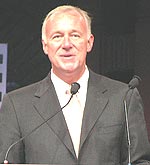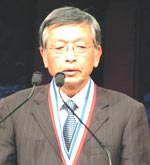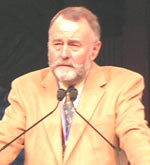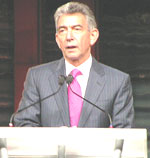Survey: U.S. cataract procedures declined in 2005
![ASCRS [logo]](/~/media/images/news/print/ocular-surgery-news-europe-asia-edition/2006/05_may/ascrslogo_175_106_16857.jpg)
SAN FRANCISCO — The number of cataract surgeries performed in the U.S. in 2005 fell 60,000 from the 2004 level, while the number of LASIK procedures remained relatively unchanged, according to results from the annual survey of members of the American Society of Cataract and Refractive Surgery.
David V. Leaming, MD, and Richard J. Duffey, MD, surveyed 4,645 active U.S. members of ASCRS and received 725 responses (16%) to their 2005 Survey of Practice Styles and Preferences.
![Richard J. Duffey, MD [photo]](/~/media/images/news/print/ocular-surgery-news-europe-asia-edition/2006/05_may/duffey_70_90_16857.jpg) Richard J. Duffey |
The estimated annual volume of cataract surgery was 2.79 million procedures, according to the researchers, down from 2.85 million in 2004. The estimated volume of refractive procedures, including PRK, LASIK and LASEK, also declined slightly, to 928,737 procedures in 2005. The change was less than 1%, and Drs. Leaming and Duffey noted that LASIK growth has been relatively flat since 2001.
The number of surgeons performing bimanual microincision cataract surgery increased slightly, to 4.4% of all procedures in 2005, from 3.3% of all procedures in 2004. Of those using the technique, 50% said they use it in 10% of cases, and 25% said they perform bimanual phaco exclusively. In 2004, 62% of surgeons using the technique said they did so in 10% of their patients, while 31% performed bimanual phaco only.
Drs. Leaming and Duffey noted that 7.4% of respondents said they plan to switch to bimanual phaco within the next year.
In the survey, which was concluded between August and October 2005, one-third of the respondents opted to implant presbyopic IOLs; the other two-thirds indicated they expect to begin implanting the lenses within the next year.
More presentations from ASCRS are highlighted in the remainder of this article. Many of these items appeared first on OSNSuperSite.com as daily reports from the meeting. Look to the print pages of Ocular Surgery News Europe/Asia-Pacific Edition for expanded coverage of selected items in the future.
Frozen irrigation solution may alleviate post epi-LASIK pain
|
Image: Boyle EL, OSN |
A topical, frozen balanced salt solution may reduce pain associated with surface ablation procedures, according to a study.
Bruce C. Larson, MD, assessed the effectiveness of preoperative treatment with frozen balanced salt solution as a means of alleviating the pain experienced within 24 hours after epi-LASIK.
The study looked at a series of 39 consecutive epi-LASIK procedures. The control group consisted of an initial series of 18 eyes that received standard epi-LASIK. A second consecutive series of 21 eyes received 50 drops of frozen balanced salt solution applied directly to the cornea before undergoing epi-LASIK. At day 1 postop, all patients were asked to rate their level of pain on a scale of 0 to 10, and the two groups were compared for the level of postoperative pain control.
For those who had been given the drops, the average pain score on a per-eye basis within the first 24 hours was 1.4 on a scale of 0 to 10.
Of the 18 eyes (11 patients) that had not been treated with the frozen solution, the average pain score reported within the first 24 hours was 4.
“The results were pretty dramatic,” Dr. Larson said. “This has largely eliminated one of the barriers to surface ablation: pain.”
Most basal cells in epi-LASIK flaps are not viable, histology study shows
Up to 90% of basal epithelial cells in epi-LASIK flaps may be dead or crucially damaged when they are replaced onto the stroma, a histology study showed. Most superficial and intermediate cells in the flaps may still be viable, however.
At the meeting, Shigeru Kinoshita, MD, described a histologic study he performed on epi-LASIK flaps that were created using three brands of microkeratome. The microkeratomes used were the Gebauer device now distributed by CooperVision Surgical, the Norwood EyeCare Epikeratome and the Moria Epi-K device.
Small peripheral sections of epithelial flaps created by each device were trimmed off with fine scissors immediately after the excimer laser ablation during epi-LASIK. The sections were processed for transmission electron microscopy (TEM) or confocal microscopy.
About half of the 22 samples showed an intact basement membrane on TEM. Staining indicated that 90% of the cells in the basal layer were dead or damaged.
Dr. Kinoshita said the high percentage of non-viable cells in the basal layer was “probably due to mechanical damage from the epikeratome cut.” He said epi-LASIK is a worthwhile surgical procedure, but the instrumentation must be improved in order to make the basal cells more biologically active.
No link between macular thickness and gentamicin in irrigating solution
The use of gentamicin in balanced salt solution cannot be conclusively linked to increased macular thickness 1 week after cataract surgery, according to a study presented here.
Yoshihide Nakai, MD, and colleagues looked at macular thickness before and after cataract surgery in 91 eyes. The researchers used optical coherence tomography to analyze macular thickness. The eyes received balanced salt solution either with or without gentamicin.
The mean thickness was 187 µm on day 7 postoperatively for the eyes that had gentamicin in the solution and 185 µm for those that received saline alone.
The researchers said “a link could not be established” between the use of gentamicin in the balanced salt solution and increased macular thickness.
“We found that gentamicin can be used safely and effectively when added to balanced salt solution,” Dr. Nakai said.
Telescopic multifocal IOL designed to address needs of low-vision patients
|
Image: Mullin DW, OSN |
A small-incision foldable telescopic IOL may significantly improve quality of vision for patients with age-related macular degeneration, according to Gholam A. Peyman, MD. He described the development of a two-zone, aspheric, three-lens design for patients with AMD during the ASCRS Innovators’ Session.
“Approximately 14 million patients suffer from low vision due to late-stage AMD,” Dr. Peyman said. “These patients require special visual aids for reading.”
The central optical zone of the new telescopic IOL provides 3X magnification for central vision, and a peripheral zone provides normal peripheral vision.
The anterior element of the lens is a small-diameter (1.5 mm), aspheric lens with high positive power. The posterior element is a larger diameter (6 mm) two-zone lens. The central portion, with a diameter of 1 mm, provides additional negative power for the telescopic zone, Dr. Peyman said.
The periphery of the posterior element provides standard IOL power to allow the patient to focus on distant objects.
According to Dr. Peyman’s abstract, theoretical optical evaluation of the telescopic IOL showed that patients achieved 3X angular magnification at a distance of 25 mm. In addition, the peripheral portion of the posterior lens provided focusing for distant objects, as well as peripheral vision for a very wide angle.
“This lens provides unobstructed peripheral field, as well as 3X magnification,” Dr. Peyman said.
Four multifocal IOLs provide excellent near and far vision
Four multifocal IOLs have “effective functional systems at all distances and limited side effects,” said Ulrich M. Klemen, MD.
Dr. Klemen spoke about four lenses: The Array, ReZoom and Tecnis (Advanced Medical Optics) and the AcriTwinSet from Acri.Tec.
Dr. Klemen randomized 60 eyes of 40 patients who had a mean baseline visual acuity of 0.8 to receive one of the lenses. All patients had binocular implantations within 1 week.
“We have excellent functions for both near and far,” he said.
After implantation, 15% of the patients with the Array reported using spectacles, compared with 10% who had the AcriTwin, 12% who had the ReZoom and 10% who were implanted with the Tecnis. A total of 10 eyes developed halo or glare: three eyes with the Array, two eyes each with the AcriTwin and ReZoom lenses and one with the Tecnis.
Dr. Klemen said he asked patients if they would have the surgery again, with the following results: eight patients each who had the Array, Acri Twin or ReZoom would repeat the surgery; nine patients who had the Tecnis would repeat the surgery.
|
Image: Mullin DW, OSN |
Simultaneous bioptics reduces surgeries
Patients who have simultaneous bioptics surgery can avoid second surgeries in most cases, Roberto Zaldivar, MD, said.
Dr. Zaldivar said success in simultaneous bioptics is reliant on patient iridectomies, accurate white-to-white measurements and skillful technique. He added that simultaneous bioptics surgeries are painless for patients.
He conducted a study comparing sequential and simultaneous bioptics in 59 eyes, with follow-up on day 1 and at 1 month. With the simultaneous bioptics, he said, patients have better initial visual acuity.
“I have had great patient satisfaction,” he said.
Potential disadvantages of simultaneous bioptics are a longer surgical procedure, complicated calculations and a higher possibility of complications because the patient is undergoing two procedures in the same operative session. There is also a possibility of residual refractive defects, he said.
Mixing, matching IOLs good option for quality vision
No single lens is ideal for every patient, making mixing and matching IOL technologies viable for better patient satisfaction, said Richard L. Lindstrom, MD.
|
|
Dr. Lindstrom, Global Chief Medical Editor of Ocular Surgery News, said every IOL technology has plusses and minuses, rendering mixing in some cases the best option for better vision. He said mixing different optical systems is not a new idea, with multifocal/monofocal and monovision contacts regularly combined. A newer idea, the mixing of conventional multifocal or accommodating lenses, is yet another option, he said.
“If you mix and match appropriately, you can lead to higher patient satisfaction,” Dr. Lindstrom said.
He said staged implantation provides a “safety net” for the surgeon to guard against possible patient dissatisfaction. He said the process works by choosing an IOL for the first eye and waiting for feedback from the patient about the quality of vision with that lens at about 2 to 4 weeks postoperative. Then the surgeon chooses the second IOL. If patients were pleased with the first lens, the same lens can be implanted. If they are unhappy with the first lens, a different lens can be selected, he said.
Good visual performance, patient satisfaction shown with Tecnis ZM
The diffractive TecnisZM multi-focal IOL has “excellent visual performance,” and may be useful for emmetropes and low myopes, Georges D. Baikoff, MD, said.
|
|
Dr. Baikoff spoke about the clinical results of implanting the Tecnis ZM (Advanced Medical Optics) lens in patients with hyperopia and presbyopia.
Over the course of 2 years, he implanted the lens in 15 patients whose mean age was 57 years. The majority of patients were hyperopic, he said. The average preoperative refraction was +2.44 D, with a range from –8 D to +6.25 D.
According to Dr. Baikoff, the IOL corrects presbyopia with “excellent near distance,” but patients should be warned of possible side effects, such as night halos. He said most of his patients accepted night vision problems.
Patients should also be forewarned about the possible reduction in vision at some distances, Dr. Baikoff said. He added that he spends “a lot of time” before surgery with his patients, describing the procedure outcomes and the technology.
“It’s very important to tell the patients any kind of presbyopia surgery will be a compromise,” he said. “They gain something in near vision, and they lose it in distance.”
Topical NSAIDs may improve vision in IOL patients
Administering ketorolac tromethamine 0.4% both preoperatively and postoperatively may improve the visual outcomes for patients who have undergone multifocal IOL implantation, according to Eric D. Donnenfeld, MD.
“I think over the past year or so, we have seen a revolution, with multifocal IOLs becoming increasingly popular,” Dr. Donnenfeld said. “We wanted to look at the effect topical nonsteroidal anti-inflammatory drugs have on the quality of vision for people with multi-focal IOLs.”
He described a multicenter prospective study to assess the effect of ketorolac tromethamine 0.4% four times daily for 3 days preoperatively and for 3 weeks after multifocal IOL implantation. Results were compared with control patients; emphasis was on quality of vision. About 40 patients in the study were implanted bilaterally with the ReSTOR multifocal IOL (Alcon), he said.
Uncorrected visual acuity, best corrected visual acuity, mesopic and photopic contrast sensitivity were assessed at 2 weeks and 3 months after the second eye implantation. Lifestyle questionnaires given at 3 months showed the patients who were also given ketorolac tromethamine had improved satisfaction with their multifocal IOLs compared to the patients who were not given the NSAID.
Dr. Donnenfeld added that using topical NSAIDs may also help prevent cystoid macular edema.
Dynamically accommodating IOL a ‘tremendous’ refractive tool, surgeon says
|
Image: Mullin DW, OSN |
A “clamshell dynamically accommodating” IOL may be an “excellent” device for refractive lens exchange, said Keiki R. Mehta, MD. He said the lens is capable of correcting high myopia and high hyperopia while retaining accommodation.
Dr. Mehta said that the lens provided a reduction in dependency on postop refractive correction and that the lens should be implanted through a clear corneal incision. He shared his results in 214 implantations.
“Most of the patients are 20/30 or better, and they are very happy with the fact that they have no need for glasses,” he said.
At 42 months, the mean uncorrected visual acuity improved from 6/36 to 6/9 at distance and from J7 to J1 at near. In 87% of the cases, best corrected visual acuity was 6/6; J1 was obtained in 74% of the patients, Dr. Mehta said. IOP ranged from 14.6 mm Hg to 17.5 mm Hg. The mean amount of postoperative accommodation was +2.5 D. Dr. Mehta said no complications were noted.
Dr. Mehta said the lens can be injected through a standard 2.8 mm incision. Even with lateral compression, he said, once locked, the lens plates do not separate. It is unlikely to lead to fibrosis, he said.
Mixing multifocal IOLs results in better overall vision
Combining two multifocal IOL technologies in one patient can result in a high rate of spectacle freedom and patient satisfaction, said Frank A. Bucci, Jr., MD.
Dr. Bucci initiated a study in which one cohort received the ReSTOR IOL in both eyes and a second cohort received the ReSTOR lens in one eye and the ReZoom lens in the contralateral eye. The ReSTOR-only group comprised 55 patients with a mean follow-up of 27 weeks. The mixed group comprised 39 patients with a mean follow up of 12 weeks.
In the ReSTOR-only group, 21 patients had cataracts and 24 had refractive lens exchange surgery.
“Implanting the ReSTOR in the second eye improved reading and caused no added halos,” he said.
The first group had a postop near visual acuity of J1, while the mixed-lens group had a near VA of 1.07, Dr. Bucci said. There was no statistically significant difference at near, he said.
No statistically significant differences in bilateral uncorrected near vision were observed, he said.
For near vision, ReSTOR was excellent in bright light for small pupils, while the ReZoom was very good in moderate light for medium pupils, Dr. Bucci said. For intermediate vision, ReZoom was excellent, while ReSTOR sacrificed intermediate for fine detail at near, he said. For distance, ReZoom had excellent bright daylight vision, while ReSTOR had less light phenomena at night.
“Why are we mixing technologies? Because it works,” Dr. Bucci said.
Optic nerve exam pointers
The essentials of optic nerve examination have five basic tenets: Systemic examination, optic disc size, neuroretinal rim, peripapillary region, disc hemorrhage and nerve fiber layer, Robert D. Fechtner, MD, said.
He called examining the optic nerve a “fundamental” of glaucoma care. The “ISNT” rule, for “Inferiorly, then Superiorly, Nasally, and thinnest Temporally,” which describes a typically healthy optic nerve, is a key to effective examination, he said. Clinicians should concentrate on the neuroretinal rim instead of the cup, he added.
“It’s (the cup), not what an optic nerve looks like,” he said.
Another essential of optic nerve examination is looking at disc hemorrhage, which can precede visual field loss. He said at every examination of a glaucoma patient, he examines the optic nerve through the dilated pupil.
“There is no reason most glaucoma patients should not have their optic nerve observed at each examination,” he said. “You might find a disc hemorrhage.”
Pseudophakic eyes at risk of iris bombé
|
Image: Mullin DW, OSN |
Pseudophakic patients with deep anterior chambers should be observed carefully for possible symptoms of iris bombé, according to a poster presentation.
Ryoji Yamakawa, MD, sought to understand the risk factors associated with this condition, which leads to uncontrolled IOP if left untreated.
“Iris bombé is often seen in phakic eyes, but in pseudophakic eyes has been rarely reported,” he said.
The noncomparative case series looked at iris bombé in eight pseudophakic eyes of seven patients at Kurume University Hospital and Tobata Kyoritz Hospital between August 2002 and September 2005.
The study included two men and five women, whose average age was 62.5 years. One eye had uveitis, one had chronic angle-closure glaucoma, and six had proliferative diabetic retinopathy.
The study found that iris bombé developed in one uveitic eye and one eye with chronic angle-closure glaucoma after phacoemulsification with IOL implantation and vitrectomy. All eyes had ongoing inflammation, small continuous curvilinear capsulorrhexis (CCC) and poor pupillary dilation. High IOP was observed in four eyes and was lowered with laser iridotomy.
In all eyes, iris bombé resolved with laser iridotomy. However, patients with proliferative diabetic retinopathy required several treatments because of repeated closure of iridotomies.
“It must be recognized that persistent inflammation, small CCC and poor pupillary dilation are risk factors for iris bombé,” Dr. Yamakawa said.
Educate glaucoma patients before refractive surgery
Education and a lifelong follow-up are strongly urged for patients with glaucoma who want to undergo refractive surgery, according to a poster presentation.
Seung Hyuck Lee, MD, and colleagues examined the clinical course of 10 eyes of 12 patients with glaucoma who had undergone refractive surgery, including LASIK for myopia, LASEK and Artisan/Verisyse lens (Ophtec/Advanced Medical Optics) implantation.
Dr. Lee compared preoperative and postoperative IOP, refractive error, visual acuity and endothelial cell counts. He said both endothelial and keratocyte cell density remained the same. Mean cup-to-disc ratio was 0.7, he said. A mean IOP decrease of 4.7 mm Hg was observed, and there was no progression in visual field loss over the course of the 1-year follow-up.
Dr. Lee said glaucoma patients may be viable candidates for refractive surgery, but the physician should monitor the patient for the rest of his or her life and should ensure a high level of patient education preoperatively as well.
Retaane may help treat steroid-induced glaucoma
The anterior juxtascleral depot administration of anecortave acetate, in conjunction with other glaucoma medications, appears effective in lowering IOP in eyes with steroid- induced glaucoma, according to a presentation.
|
|
The study, presented by Alan L. Robin, MD, examined the IOP increase that is a frequent complication of treatment with intravitreal triamcinolone acetate.
“The increase in IOP with triamcinolone is a problem that has become an epidemic,” Dr. Robin said.
The IOP spike associated with triamcinolone may in part be a result of changes in the trabecular meshwork, including a significant induction of myocillin. Anecortave acetate, a cortisene, lacks the usual anti-inflammatory and immonosuppressive properties of glucocorticoids, Dr. Robin said. The drug is marketed as Retaane by Alcon.
The study concluded that in combination with other glaucoma medications, “this administration of anecortave acetate was safe and effective in lowering IOP in patients with steroid-induced glaucoma,” Dr. Robin said. The delivery of this treatment does not require patient compliance.
“In summary, this is a new class of medicine, and a new way of delivery,” Dr. Robin said. “It lowers IOP in six out of seven eyes, and may have some potential advantage in the treatment of primary open-angle glaucoma.”
Multifocal, monofocal combination has high patient satisfaction
|
Image: Mullin DW, OSN |
Implanting one multifocal and one monofocal lens can offer patients improved near and distance vision, said Richard Tipperman, MD.
Dr. Tipperman suggested that surgeons may consider piggyback placement of ReSTOR IOLs (Alcon) in patients who previously had bilateral monofocal IOLs implanted. He presented results from a subset study of 10 patients implanted with the ReSTOR lens in one eye and the AcrySof monofocal lens (Alcon) in the fellow eye. Nine patients had been previously implanted with two monofocal lenses.
Patients were given a questionnaire asking them to describe their “feelings” and “thoughts” about such everyday activities as reading, watching television and using the computer, with or without glasses. They rated their vision quality on a 10-point scale, he said.
Nine patients graded reading with glasses as at least a 6; nine were able to watch television comfortably (graded a 10), and seven patients rated using a computer comfortably as an 8.
Dr. Tipperman cautioned that the study was small and “not scientific,” but is a start at examining patient expectations and outcomes.
“It’s a way of beginning to look at [combination implantations],” he said.
Collagen device useful for refractory glaucoma
A collagen device designed to treat glaucoma may be an effective alternative for surgical treatment of refractory glaucoma, according to a presentation made here.
Svetlana Y. Anisimova, MD, discussed potential applications for a new, elastic porous implant of xeno-collagen (type 1) with sulfated glycosaminoglycans that she said can exist in the intrascleral space for several years. In her study, Dr. Anisimova included 72 eyes of 62 patients with refractory glaucoma. One group had undergone non-penetrating surgery and the other group had undergone angle-uveal insertion of the collagen device. The mean IOP for both groups was 28.5 mm Hg, and the patients averaged two medications a day before surgery. A total of 32 eyes had previously undergone different filtering and laser procedures.
None of the patients in either group had postop inflammatory responses, Dr. Anisimova said. Postoperatively, after 3 years of follow-up, 85% of the patients had IOP no higher than 21 mm Hg, with the mean being 16.7 mm Hg. The average amount of medication for 21 patients dropped to an average of one to two. In 17 cases, YAG laser was performed between 1 and 3 years after initial surgery.
“There was no fibrosis around the implant, and good poral structure,” Dr. Anisimova said. “The effect was very good in all cases.”
Bee and wasp sting injuries: manifestations and effects
|
Image: Mullin DW, OSN |
Hymenoptera sting injury is common in rural India, and clinicians should be educated regarding the many manifestations of this phenomenon, according to a poster presentation.
Nibaran Gangopadhyay, MD, recommended that physicians become familiar with the varied manifestations after ocular injury caused by bee or wasp stings.
In his case series, two patients from a rural area of India consecutively presented with bee and wasp stings in the cornea. One patient, a 25-year-old male, developed immediate corneal epithelial defect and sterile infiltrate followed by severe inflammation, which led to endothelial dysfunction and cataract from venom toxicity. The corneal scar and cataract led to severe visual deficit in this patient, Dr. Gangopadhyay said.
The other patient, a 13-year old boy, suffered a wasp sting on the peripheral cornea and subsequently developed symblepharon formation, limbal ischemia, secondary yeast infection, corneal endothelial dysfunction and significant visual loss. Medical treatment seemed unlikely to prevent long-term complications and visual disability.
“Knowledge on various manifestations enriches understanding, leading to prompt and proper treatment, to limit the serious consequences,” Dr. Gangopadhyay said.
Phakic IOLs may help patients gain lines
A phakic IOL is effective in correcting spherical and astigmatic errors, while offering a safe, efficient and stable surgical outcome, Sabine Buchner, MD, said.
She presented results in 66 eyes that had been implanted with the Artisan/Verisyse IOL (Ophtec Advanced Medical Optics). The preoperative refraction ranged from –21.25 D to –0.25 D in 50 eyes with myopia; 16 eyes with hyperopia ranged in refraction from +2 D to +6.13 D.
The annual cumulative cell loss of 1.7% was as expected, she said. In the group with myopia, at 3 years 85% had gained one or more lines of acuity. Of those with hyperopia, 70% had gained one or more lines at the same follow-up period, she said.
Multifocal IOL allows spectacle independence
Nearly 100% of patients receiving an apodized diffractive IOL in a study were spectacle-free 1 year after surgery, Robert A. Kaufer, MD, said.
He spoke about a year-long study he conducted in Argentina on a total of 51 patients implanted with the ReSTOR IOL (Alcon).
Dr. Kaufer said 99% of patients had spectacle freedom, and 100% would have the same surgery again. They would also recommend the surgery to their best friend, he said. The majority of patients reported no or mild night vision problems, halo or glare. The side effects were deemed “tolerable” by the patients and were not intrusive enough to forego having the surgery, they said.
The mean uncorrected distance vision was 20/20, and mean uncorrected near visual acuity was 20/16. Mean uncorrected intermediate VA was 20/25, Dr. Kaufer said.




![Richard L. Lindstrom, MD [photo]](/~/media/images/shared-images/richard-l-lindstrom-md.jpg)
![Georges D. Baikoff, MD [photo]](/~/media/images/news/print/ocular-surgery-news-europe-asia-edition/2006/05_may/baikoff_70_90_16857.jpg)


![Alan L. Robin, MD [photo]](/~/media/images/shared-images/robin_70_90_16857.jpg)

